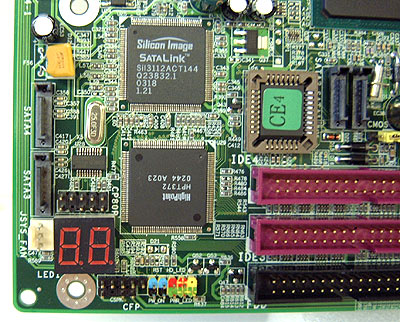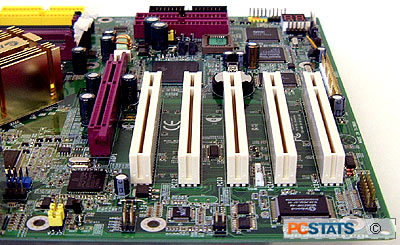As you can see, the Epox 4PDA2+ is a pretty busy
motherboard but the layout is still good. The 4PDA2+ has the main IDE and ATX power
connectors placed in their ideal location to the right of the DIMM slots. Sure
the ATX12V power connector is to the left of the Northbridge, but with the cable
so small it will not affect airflow much.
 The secondary IDE channels and Floppy drive connectors on
the 4PDA2+ are place a bit lower on the motherboard and unless you're using full
length PCI cards you won't have any problems.
The secondary IDE channels and Floppy drive connectors on
the 4PDA2+ are place a bit lower on the motherboard and unless you're using full
length PCI cards you won't have any problems.
It's also a nice treat to be able to install and remove memory on the
4PDA2+ without having to first remove the videocard.
Incidently, the
Northbridge heatsink is located far enough from the AGP slot that GPU heatsinks like
the like the Zalman ZM-80A HP are installable.
Epox have thrown in many features (firewire, SATA,
USB, audio, etc.) that you're likely to require, aside from dual BIOS's that
is.
On a motherboard such as this, there really is no
getting around the fact the 4PDA2+ really should have a backup
BIOS.
One thing
I was extremely happy to see was that the 4PDA2+ includes a secondary Serial ATA
RAID controller (Silicon Image Sil3112ACT144) in addition to a secondary Ultra/133
IDE RAID controller (HighPoint HPT372). The Silicon Image chipset also
accomodates future SATA on ATAPI devices like CROMs, CDR/RW drives and so
forth.
It seems
like manufacturers are really on the push to move everything to Serial ATA, forgetting in this midst of this that that most
computers currently in use are still working just fine with IDE hard drives. I for one know that I would not
want to buy an additional PCI IDE controller if I were upgrading my motherboard. Just
goes to show you that Epox has some pretty good foresight in this
arena.

One feature
on the EPDA2+ that I find very useful is the Port 80 diagnostics card. From memory errors, to
videocards and even CPU cache problems, if you're experiencing hardware related issues
the Port 80 can be a real lifesaver when it comes to diagnosing the
problem.
The Intel
i965PE Springdale chipset has some very unique technologies built into it, so if you're interested
in knowing more I recommend you see this review review where we cover the basics in
detail.
